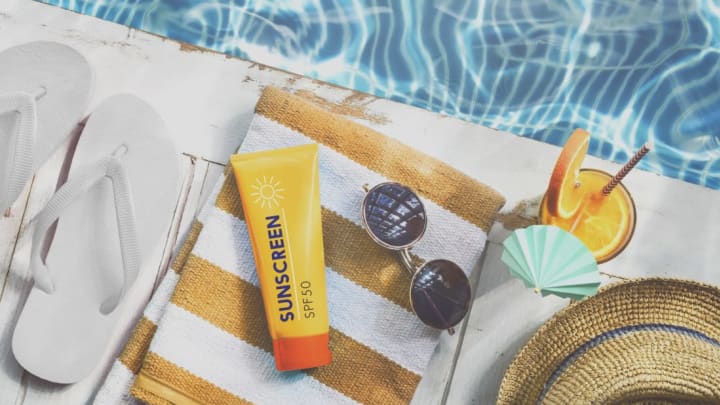I’m a pale person. A very pale person. Which means that during these hot summer months, I carry sunscreen with me at all times, and apply it liberally. But I’ve never really understood what those SPF numbers meant, so I asked some sun care to break it down for me—and to tell me how to best apply the stuff so that I can make it through the summer without looking like a lobster.
Soaking up the sun ... safely
SPF stands for Sun Protection Factor, and it indicates a sunscreen’s ability to block UVB rays. The concept was pioneered at the Coppertone Solar Research Center in 1972; in 1978, the FDA published an SPF method based on Coppertone’s system, according to Dr. David Leffell, chief of Dermatologic Surgery and Cutaneous Oncology at Yale.
The numbers themselves stand for the approximate measure of time a person who has applied the sunscreen can stay out in the sun without getting burned. Say you get burned after 20 minutes in the sun without sunscreen; if properly applied (and reapplied), SPF 30 will allow you to stay in the sun 30 times longer without burning than if you were wearing no protection at all. So, theoretically, you should have approximately 600 minutes, or 10 hours, in the sun. But it’s not an exact science because the amount of UV light that reaches us depends on a number of factors, including cloud cover, the time of day, and the reflection of UV rays off the ground, so it’s generally recommended that you reapply sunscreen every two hours (or even sooner).
What gives a sunscreen a higher SPF comes down to the product’s formulation. “It’s possible that an SPF 50 might contain slightly more of one or more sunscreen active ingredients to achieve that higher SPF,” Dr. Patricia Agin, president of Agin Suncare Consulting, says. “But it’s also possible that the SPF 50 might contain an additional active ingredient to help boost the SPF performance to SPF 50.”
No matter what SPF your sunscreen is, you’ll still get a burn if it’s not properly applied. So let’s go over how to do that.
How to apply sunscreen
First, make sure you have a water-resistant, broad spectrum sunscreen—which means that it protects against both UVB and UVA radiation—with an SPF of at least 30. “Typically, you don’t have to buy sunscreen that has an SPF higher than that unless you have very sun sensitive skin,” Leffell says. “That’s a very small percentage of the population.” (Redheads, people with light eyes, and those who turn pink after just a few minutes in the sun—you’ll want to load up on SPF above 30.)
Twenty minutes before you go out to the beach or the pool, begin to apply your sunscreen in an even coat. “Don’t apply it like icing on a cake,” Leffell says. “I see these patients and they’ve got the tops of their ears covered with thick, unevenly applied sunscreen, and that’s not a good sign.” Sunscreen sprays will easily give you that even coat you need.
Whether you’re using lotion or a spray, when it comes time to apply, Leffell recommends starting with your scalp and face, even if you plan on wearing a hat. “Make sure you’ve covered the ears and nose and under the eyes,” Leffell says. “Then, I would move down to the shoulders, and make sure that someone can apply the sunscreen on your back beyond the reach of your hands.”
Other areas that are important that you may forget to cover, but shouldn’t, are the tops of your feet, the backs of your hands, and your chest. “We see it all the time now—the v of the chest in women has become a socially and aesthetically huge issue when they are 50 and beyond. Because even though they can treat their faces with all sorts of cosmetics and procedures, the chest is much harder, and they are stuck with the face of a 40-year-old and the chest of a 60-year-old. You want to avoid that using sunscreen.”
Another important thing to keep in mind: Water-resistant doesn’t mean waterproof. “I always tell patients to reapply every couple of hours while you’re active outdoors," Leffell says, "and always reapply when you come out of the water or if you’ve been sweating a lot, regardless of whether the label says water resistant."
Determining whether or not you’ve succeeded in properly applying your sunscreen is easy: “You know you’re applying your sunscreen properly if, after the first time you’ve used it, you haven’t gotten a burn,” Leffell says.
Agin has a caveat, though: "It’s not a good idea to think of sunscreens only as a way to extend your time in the sun," she says. "One must also understand that even before becoming sunburned, your skin is receiving UV exposure that causes other damage to the skin. At the end of the 600 minutes, you will have accrued enough UV to cause a sunburn—one Minimal Erythema Dose or MED—but there is pre-MED damage done to skin cells’ DNA and to the skin’s supporting structure of collagen and elastin that is not visible and happens even before you sunburn. These types of damage can occur without sunburning. So you can’t measure all the damage done to your skin by only being concerned about sunburn."
Have you got a Big Question you'd like us to answer? If so, let us know by emailing us atbigquestions@mentalfloss.com.
An earlier version of this post ran in 2014.
